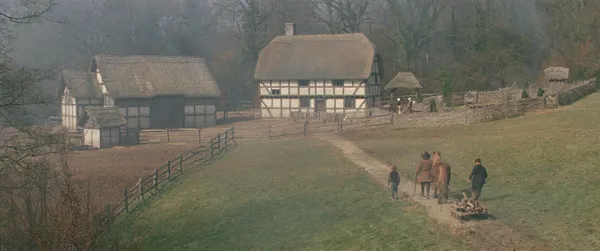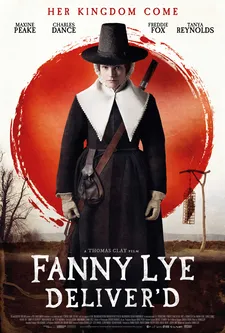 |
| Fanny Lye Deliver’d Photo: Edinburgh International Film Festival |
The latest film from Brighton-born director Thomas Clay, and part of this year’s Edinburgh international Film Festival selection (screening online in partnership with Curzon), Fanny Lye Deliver’d is unlike anything else you’ll see this year. A powerful drama set in the aftermath of the English Civil War, it focuses on Fanny (Maxine Peake), a modest housewife living on a farm with her husband John (Charles Dance) and young son Arthur (Zak Adams) whose life is turned upside down by the arrival of two strangers. Thomas (Freddie Fox) and Rebecca (Tanya Reynolds) are members of a recently formed religious sect with very different attitudes to faith and sexuality, and they bring trouble in their wake – but Fanny is made of steelier stuff than anyone suspects.
The director has spoken at length about his passion for this period in history, so I ask him for his thoughts on why so few films to date have been set in it.
 |
| Maxine Peake as Fanny Photo: Edinburgh International Film Festival |
“I think cinema, and the history that’s taught in our schools as well, likes to focus on kings and queens and grand historical events, and for some reason the Civil War period doesn’t get enough of a look in, especially the history of the radical thinkers. They maybe didn’t have a huge impact on the physical outcomes of events but I think they had a huge impact on the intellectual, political and religious development of the country and globally. The influence reaches out, you know: the French Revolution, the American Revolution – perhaps without these ideas that began in England in the 1640s and ‘50s, those things may not have happened.”
How did Fanny’s story develop?
“For a long time I’ve wanted to make a film about that period of history. I read the book The World Turned Upside Down and just, for years, wanted to find a way in. The eureka moment was thinking that I could maybe combine that with a western of sorts and have this single location with Fanny in the middle and each character in the film representing a different ideological position within society at that time.
“Once I’d had the idea then it all flowed from there. I spoke to researchers and historical experts. Actually there’s a large reenactment community in England and there’s a depth of knowledge there to do with social history, clothing, food – that was very helpful as well. The script came together in a bit over a year.
“I thought it would be interesting to have a western with a female protagonist, which, when I was writing in 2012, wasn’t very common. having read a lot of the pamphlets and learned about the real people of the time, it felt important to me to cover that aspect of the history that you had, especially in the Quaker movement – you had the early beginnings of women’s rights and people who really put their lives on the line. Some were sent to prison. One or two were even executed for their beliefs. I felt that needed to be represented too.
 |
| Maxine Peake and Charles Dance as Fanny and John Photo: Edinburgh International Film Festival |
“The Puritan establishment was very patriarchal. That’s why she ultimately moves towards Quakerism.”
There’s a lot of sexuality in the film, though little actual nudity, and what might perhaps have been more shocking to people at the time is Fanny getting the chance to learn to read.
“Working women at the time didn’t have access to education. There are examples to individuals – people like Mary Dyer – who wrote pamphlets and were essentially self taught,” he says. “Thomas and Rebecca are what you’d call Ranters and for the Ranters, sexuality was at the heart of their philosophy so that had to be part of the film but at the sane time you don’t want it to be exploitative, obviously, so I was careful about finding the right way to do that.”
His team’s commitment to historical accuracy extended to actually building the house and farm buildings where the film was shot.
“Instead of it being a traditional film set we used traditional methods and brought in craftsmen, again through the reenactment community,” he explains. “There’s knowledge there which we were able to draw on, thatchers and blacksmiths and other specialists.
“To have that level of detail in the set, it really helps, especially for actors, I think, to be able to walk into the set and really feel that they’re going back in time and walking onto a farm in the 17th Century. We had animals as well. We had pigs that were actually in the sty, being looked after by our animal handler. There was a feeling of veracity.
“We had temporary planning permission and the landowner took over the buildings. It was his choice. He could either take them down or possibly convert them into farm buildings or something else. I don’t know what he decided to do in the end.”
 |
| Tanya Reynolds and Freddie Fox as the Ranters Photo: Edinburgh International Film Festival |
They shot the film in winter, which is always a challenge. Was that intentional or just a result of the way that scheduling worked out?
“We wanted it to be winter,” he says. “That’s the period in the farming season when the family would be more likely to be alone. The rest of the time they would have to have workers living on the farm, to work in the fields... We were kind of up against it with spring coming in so we shot all of the exteriors before we went and shot the interiors, to try and catch them before the buds started to arrive.”
This wasn’t the only problem caused by the changing seasons.
“Yeah, there was flooding. On the floor of the kitchen the water would well up every few hours through the flagstones towards the end of the shoot. The weather was very changeable and quite cold but overall everyone had a good time.”
How did he manage to find funding for a film that was so unusual and faced so many challenges? He explains that initially he and his team spoke to the BFI and to a German television company, who took an interest in the script. “Once you have that kind of seed you go on from there and bring on additional funding. You start casting and it gradually builds over a period of a couple of years.”
Maxine Peake came on board early.
“Yeah, about a year before we shot. I think that was really important actually. I had a great initial meeting with Maxine where it became clear that she also had a love for this period of history, and her vision of how the film should be made was the same. Having that grounding was really important.”
And Charles Dance? It’s difficult to imagine anyone else fitting that role so well.
“He read the script and really liked the idea of the part. It was quite near the end because we were only able to lock our schedule down very last minute. The other parts were cast quite late. Charles came in, I think, the second week of the shoot.”
 |
| Fanny Lye Deliver’d poster Photo: Edinburgh International Film Festival |
The actors had to get the hang of a very particular way of speaking that reflects the language of the time but remains intelligible to a modern audience.
“Early on in the writing stage we had a language expert to help,” says Thomas. “It was about finding a balance so that it would flow and the language would not get in the way of the film. When we worked with the actors we had a dialect coach which some of them used and some didn’t, but everyone got into it.”
The film also uses narration which suits the style of the period.
“I think it has a fairy tale kind of feel, although the voiceover is actually something that I came to in post-production. I was looking for a way to maybe shorten the running time, so I thought I’d get somebody to come and read some of it and I quickly fell in love with the idea, and now I can’t imagine the film without the voiceover.”
It’s more impressive because this was Tanya’s first screen role.
“We were casting for the part and Tanya sent in a tape for the casting director, and it was amazing that in this short piece of material she’d been sent she somehow managed to really understand and grasp the character and embody the character. I felt like she was a Ranter, screaming out of this tape. so we brought her in for just one face to face audition and it was immediately apparent that she was the best person for the part.”
Then there’s the music, which, in an unusual move, Thomas ended up composing himself.
“I did. It wasn’t intended. I studied music at university but films took over and it was something I hadn’t done for a long time. We had this very long period looking for a composer and whilst we were editing the film, over about six months, I was thinking about the music a lot and ideas started to pop into my head. By the time we had a composer I had such a fixed idea of how I wanted the music to sound that we couldn’t really reach an accommodation. At that point I created a couple of demos and showed them to the rest of the team and we all decided that I should just do it myself. It proved to be quite an undertaking. It ended up taking me about a year to compose the score – it was the first time I’d really done anything like this.”
Did it help to have experts in the musical instruments of the period involved?
“That was the concept really – not to use any instruments that didn’t exist in the 17th Century. We were able to keep the string section but all of the wind and brass had to be replaced. It was a little project in itself really. Each of the characters has an instrument associated with them, like a cornet for Fanny... It was just great to hear all the musicians playing the music – a quite incomparable experience.”
How does he feel about the film coming out during lockdown, and appearing at this year’s unusual edition of the Edinburgh International Film Festival?
“My first film [The Great Ecstasy Of Robert Carmichael] played there in 2005, so it’s nice to be selected again,” he says. “Obviously we did envisage this as a theatrical film but the most important thing is that it’s finding an audience. I’m just pleased that more people are finding out about it as well.”
So what is he working on now?
“I like to do something different each time. Possibly a musical. I don’t know. Most of the last few months have been involved in getting the release here. It’s coming out in the ‘States next month.”
In the UK, you can watch Fanny Lye Deliver’d from 26 June. it's available on Curzon Home Cinema as part of EdFilmFest @Home and also on iTunes, Amazon, Sky, Virgin, Google , Rakuten, BT , Playstation, Microsoft, BFI Player and Volta.





















